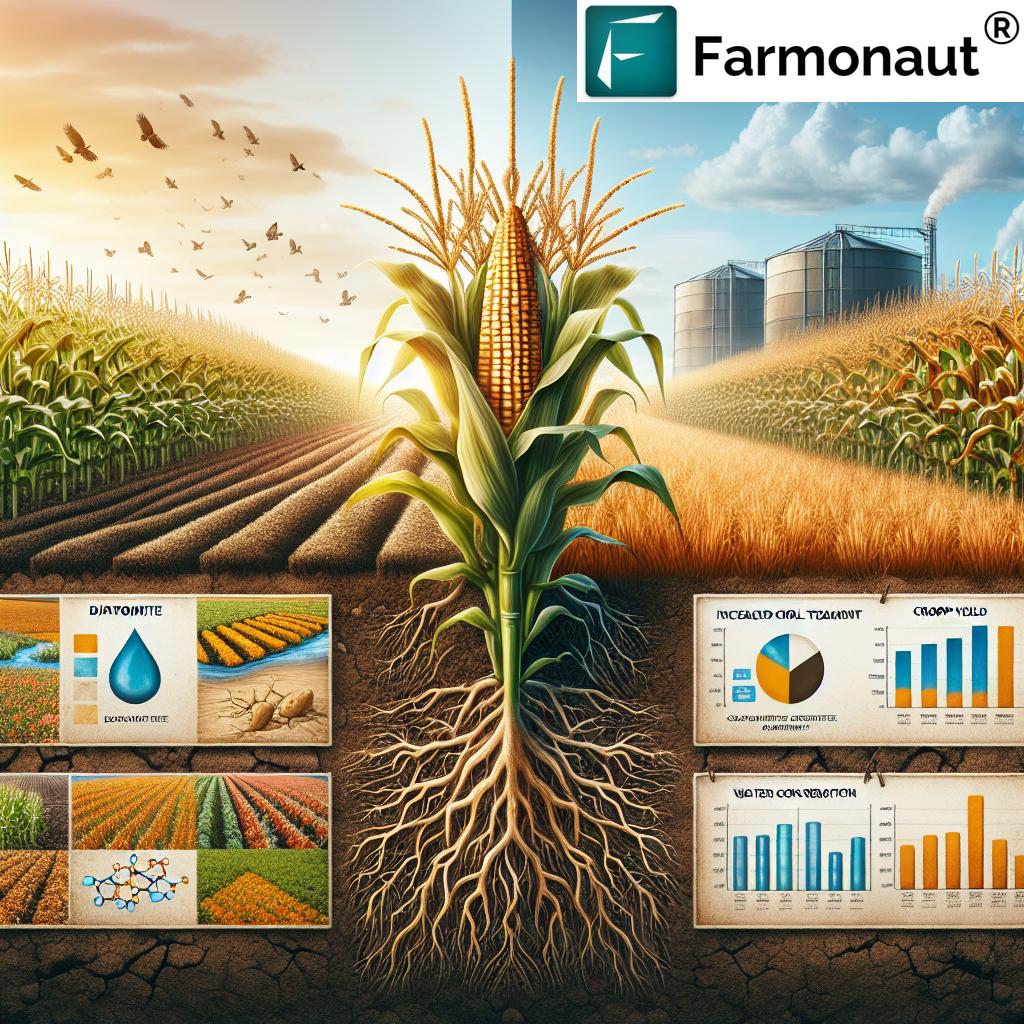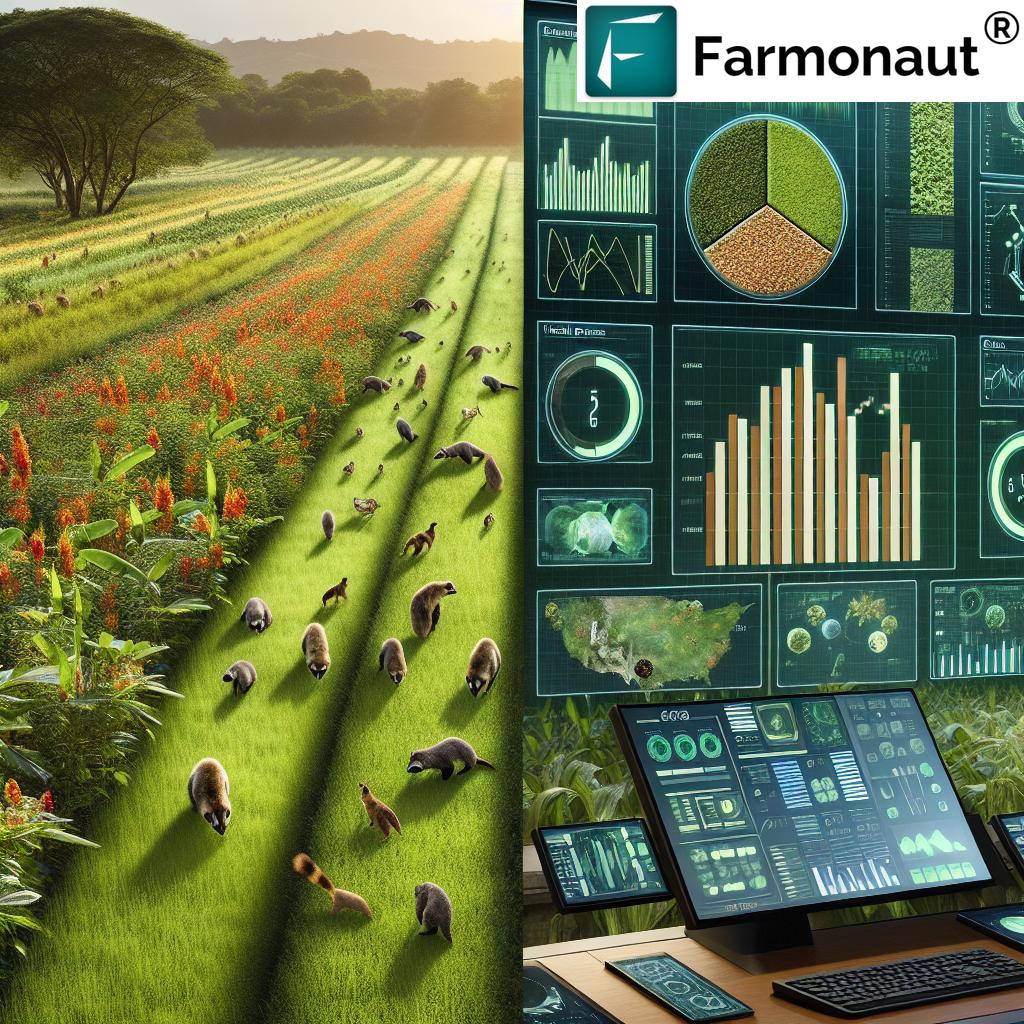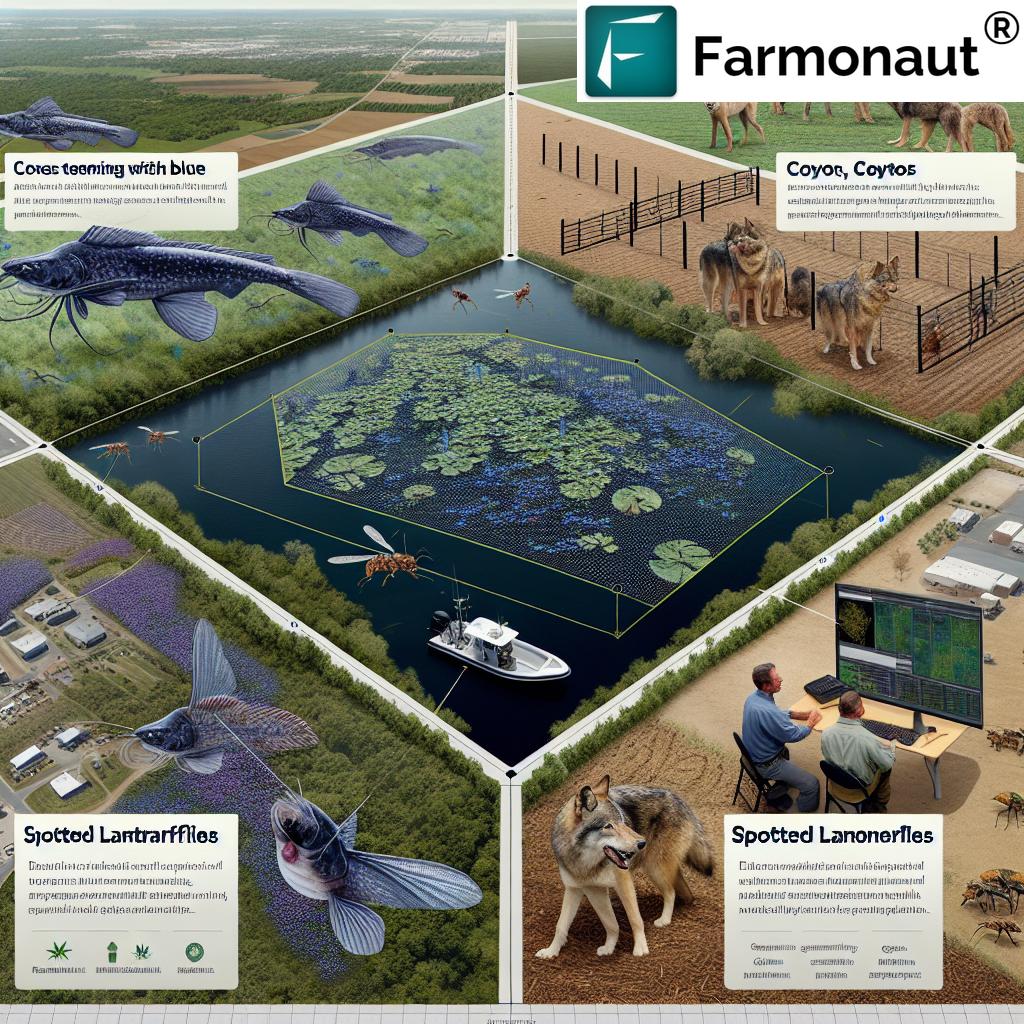Agriculture Alabama 2025: Innovation Driving Farming Success
Meta Description: Agriculture Alabama 2025: Explore how precision ag tech, biotech crops, and sustainable practices power farming success and redefine Alabama state agriculture.
Table of Contents
- Alabama State Agriculture: A 2025 Overview
- Agricultural Landscape and Production in Alabama
- Livestock and Forestry: The Backbone of Alabama Agriculture
- Agricultural Innovation in Alabama: The Rise of Precision Tech and Biotech
- Sustainable Farming Practices for a Resilient Future
- Technology Adoption Impact Table
- Meeting Market Demands: Challenges and Opportunities in 2025
- The Role of Farmonaut: Leveraging Satellite Technology for Alabama’s Farmers
- Farmonaut Apps, API & Resource Links
- Future Outlook: Smart, Sustainable, and Profitable Alabama Farming
- FAQs: Agriculture Alabama 2025
Alabama State Agriculture: A 2025 Overview of Farming in Alabama
Agriculture Alabama continues to stand as a cornerstone of the state’s economy and cultural heritage in 2025. Located in the southern United States, Alabama is renowned for its diverse climate, fertile soil, and varied geography—from the Appalachian foothills in the north to the coastal plain in the south, touching the Gulf of Mexico. This diverse geography offers a favorable environment for a wide range of agricultural activities, making agriculture a vital industry that supports rural communities and contributes significantly to state and national food security.
As of 2025, farming in Alabama is defined by its resilience, continuous adaptation, and embrace of innovation. The sector encompasses both traditional and modern enterprises, ensuring the state remains a leading agricultural powerhouse in the southeast US.
Agricultural Landscape and Production in Alabama
The Broad Spectrum of Farming in Alabama
Agriculture of Alabama encompasses a broad spectrum of crops and livestock production, reflecting the state’s varied geography and climate gradients. Alabama’s top crops include poultry, cotton, soybeans, corn, peanuts, and a growing range of specialty vegetables. These commodities contribute heavily to agricultural revenue, with poultry (especially broiler production) remaining a substantial economic driver, supporting numerous jobs and generating export revenues.
Key reasons for success in Alabama state agriculture include:
- Diverse climate enabling a wide range of crops and activities
- Fertile soil supporting high productivity
- Innovative management practices and modern technology
Top Crops and Their Economic Impact
- Poultry – Particularly broiler chickens, primary contributor to farming Alabama revenue and a large export market.
- Cotton – Long a staple crop, new biotech and precision techniques have increased output per acre.
- Soybeans – Highly valued for food, animal feed, and biofuel; ongoing improvement through biotech seeds.
- Corn – Key for both food and livestock feed, supported by advancements in irrigation and pest control.
- Peanuts – Benefiting from improved seed technology and efficient management.
- Vegetables – Tomatoes, sweet corn, and specialty greens are on the rise, aligning with consumer demand for locally sourced and sustainably grown food.

Alabama’s agricultural production is thus not only a reflection of its heritage but also a response to market and environmental challenges. This adaptability positions farming in Alabama for ongoing growth in a changing economic landscape.
Livestock and Forestry: The Backbone of Alabama Agriculture
In addition to crops, Alabama’s livestock sector is robust and highly diversified. Cattle farming and hog production play key roles alongside the dominant poultry industry. Farmers have tailored their practices to meet both national and international demand.
- Poultry remains the leading contributor, especially in the broiler category.
- Cattle and hog operations are distributed across the Appalachian foothills and coastal plain.
- Dairy farming, though smaller in scale, also adds important agricultural value.
Forestry is another significant element in Alabama’s economic landscape. The state boasts millions of acres of pines and hardwoods, with sustainable forest management becoming a top priority. These forests support timber production and related industries while providing crucial environmental benefits.
Sustainable Forest Management Approaches
- Regeneration planning and harvest schedules that balance economic needs and ecosystem health
- Soil and water conservation measures for long-term productivity
- Wildlife protection and biodiversity management programs
Agricultural Innovation in Alabama: The Rise of Precision Tech and Biotech
Precision Farming Alabama: Technologies Shaping 2025 and Beyond
The adoption of precision agriculture technologies has transformed farming Alabama in recent years. These innovative techniques—from GPS-guided equipment to drones, soil sensors, and remote sensing—optimize input use, reduce waste, and enhance yields. This tech-centric shift is helping farmers meet challenges posed by climate variability and market demands.
- GPS-Guided Equipment – Enables precision application of seeds, fertilizers, and pesticides, reducing waste and increasing efficiency.
- Soil Sensors – Real-time data on soil health, moisture, and nutrients allow site-specific management.
- Drones and Aerial Imaging – Monitor large fields for crop stress, pest infestations, and yield forecasting.
- Advanced Irrigation Systems – Minimize water use while optimizing yields.
- Biotech Seeds – Engineered for disease resistance, higher productivity, and adaptation to Alabama’s climate. Studies estimate up to 25% yield increases compared to 2020 due to widespread biotech adoption.
Benefits of Digital Technology and Data in Alabama State Agriculture
- Higher efficiency—by optimizing resources, reducing costs, and boosting yields
- Improved crop and livestock health through precision monitoring and targeted interventions
- Reduced environmental impact by minimizing unnecessary chemical and water use
- Better adaptation to climate variability and extreme weather
Adoption rates in 2025 are projected to reach over 60% for major technologies like GPS-guided equipment, drones, and smart sensors on Alabama farms.
Sustainable Farming Practices for a Resilient Future
Sustainability is at the heart of agriculture Alabama’s future. Farmers are increasingly adopting methods that protect soil health, conserve water, and increase resilience to climate risks.
- Soil conservation techniques—crop rotation, cover cropping, and reduced tillage—improve fertility and fight erosion.
- Water-smart irrigation—using data from sensors and weather forecasts to optimize water delivery.
- Integrated pest management—combining biological, cultural, mechanical, and chemical methods to minimize pest losses.
- Organic and regenerative agriculture—gaining momentum as consumer preferences shift toward ethical, local, and sustainably produced food.
Climate-Smart Agriculture: A Key to Meeting Challenges
Alabama is not immune to climate threats. Increased weather variability, frequent droughts, and flooding events present significant challenges. Through sustainable practices, strategic use of technology, and adoption of climate-resilient crop varieties, Alabama’s farmers are leading the way in climate adaptation.
Technology Adoption Impact Table: Precision Agriculture & Biotech in Alabama 2025
| Technology / Practice | Estimated Adoption Rate (% of Alabama Farms, 2025) | Estimated Yield Improvement (%) | Estimated Input Reduction (% fertilizer/pesticide) | Estimated Sustainability Score |
|---|---|---|---|---|
| Precision Irrigation | 58% | 10-15% | 30% | High |
| Biotech Seeds (Drought/Disease Resistant) | 67% | 20-25% | 20% | High |
| Drones & Remote Sensing | 61% | 12-18% | 25% | High |
| Soil Sensors & Data Analytics | 54% | 10-12% | 22% | Medium-High |
| Blockchain Traceability | 12% | 5% | 10% | High |
| Fleet & Resource Management Software | 30% | 8% | 16% | Medium |
| Regenerative/Organic Practices | 17% | 8-10% | 18% | High |
Meeting Market Demands: Challenges and Opportunities in 2025
Navigating Alabama’s Agricultural Challenges
While alabama state agriculture boasts many strengths, several challenges remain in 2025:
- Climate Change Threats: Increased frequency of extreme weather events (drought, heavy rains, hurricanes from the Gulf) threaten yields and livestock health.
- Labor Shortages: Difficulty in attracting and retaining workers pushes demand for mechanization and smart solutions.
- Soil Degradation: Intensive farming places pressure on soil health, making sustainable management critical.
- Volatile Markets: Commodity price swings and evolving consumer expectations require flexible production strategies.
- Global Competition: Access to international markets and adherence to export standards are paramount.
Opportunities Shaping Alabama’s Farming Future
- R&D Programs: State-funded programs encourage climate-resilient crops and new practices adoption.
- Emerging Local Food Systems: Efforts to diversify crops and support locally sourced products.
- Specialty and Organic Markets: Alabama farmers are introducing specialty and organic vegetables with premium returns, aligning with consumer preferences.
- Access to Gulf Transit Points: Proximity to ports on the Gulf greatly supports exports and trade efficiencies.
- Farmer Cooperatives: Expansion of cooperative initiatives supports small and medium-scale operations.
The Role of Farmonaut: Leveraging Satellite Technology for Alabama’s Farmers
As Alabama’s farming landscape becomes more competitive and technologically advanced, satellite-driven solutions are becoming indispensable. We at Farmonaut are committed to helping farmers across Alabama succeed in this evolving domain through accessible, advanced monitoring and management tools.
Why Satellite Technology Matters for Agriculture Alabama
- Real-time Crop Monitoring: Our satellite-based systems offer precise insights into crop health, soil conditions, and resource status. Farmers can detect stress, diseases, and nutrient deficiencies early, thereby optimizing inputs and minimizing losses.
- AI & Blockchain Integration: With the Jeevn AI Advisory System, we provide actionable recommendations on weather, field operations, and sustainable practices. Blockchain-based product traceability ensures transparency and trust from farm to table.
- Environmental Impact Tracking: Actionable carbon footprinting data empowers Alabama’s farming community to comply with regulations while adopting more environmentally responsible practices.
- Resource Management Tools: Fleet and large scale farm management help optimize logistics, reduce costs, and enhance on-field decision-making.
- APIs and Developer Support: With the Farmonaut API, businesses and developers can seamlessly integrate real-time satellite insights into their own systems. See the API documentation for full technical details.
Farmonaut’s value lies in delivering cost-effective, scalable solutions that empower individual users, businesses, and government bodies across Alabama. We enable everyone from small family farms to large corporate operations to access best-in-class satellite intelligence—without expensive hardware or complicated onboarding.
For Alabama farmers and agribusinesses managing loans and risk, our satellite-based crop loan and insurance verification helps streamline financing, reduce fraud, and improve access to lending.
Accessible Anytime, Anywhere: Farmonaut Multiplatform Support
Access Farmonaut via:
For corporate and large-scale managers, the large scale farm management suite streamlines mapping, field monitoring, and complex agribusiness workflows on one secure platform.
Sustainability and Transparency
Our commitment to sustainability is reflected in solutions that balance efficiency with environmental stewardship. Carbon Footprinting and Traceability tools deliver actionable, verifiable data—empowering Alabama’s farmers to align with future global food standards.
Farmonaut Apps, API & Resource Links
- Farmonaut Web App: Access powerful crop monitoring and resource management via your browser—ideal for Alabama’s digital-savvy producers.
- Android App: Monitor your crops, receive AI advisories, and manage operations directly from your smartphone.
- iOS App: Get satellite-driven farm insights optimized for Apple devices.
- Farmonaut API: Integrate real-time farm data, crop monitoring, and weather insights into your own business platforms.
- API Developer Documentation: Read technical guides for seamless API integration.
Farmonaut Subscription Options
Choose a Farmonaut subscription plan that fits your needs and scale up as you grow:
Future Outlook: Smart, Sustainable, and Profitable Alabama Farming
Looking at 2025 and beyond, the future of agriculture Alabama shines brightly. Emerging technologies like advanced biotech seeds, satellite-driven remote sensing, and AI-powered advisory tools will continue to drive innovation. Progress in sustainability—via carbon footprint monitoring, organic production, and regenerative farming—positions Alabama as a leader in responsible food systems of tomorrow.
Farmers who seize these opportunities and evolve with consumer preferences, regulations, and global standards will be best placed for lasting success. Alabama’s cornerstone sector is not just part of the state’s heritage—it is a key to a resilient, thriving, and prosperous future for all its rural communities and economic contributors.
FAQs: Agriculture Alabama 2025
What are the most important crops in Alabama in 2025?
Poultry, cotton, soybeans, corn, peanuts, and specialty vegetables remain at the top. Emerging trends include organic and locally sourced produce as well.
How has precision agriculture changed farming in Alabama?
Precision agriculture technologies—such as GPS-guided equipment, drones, and soil sensors—enable farmers to increase yields, reduce input waste, and respond more effectively to environmental and market fluctuations. Adoption is expected to exceed 60% in 2025.
What role does Farmonaut play in Alabama’s agriculture sector?
We provide satellite-based crop monitoring, soil health analytics, resource management tools, blockchain traceability, and environmental impact tracking. These tools support farmers, agribusinesses, and governments in making data-driven decisions efficiently, sustainably, and affordably.
What are the key sustainability trends for Alabama farming in 2025?
Trends include regenerative agriculture, organic practices, water conservation, carbon footprint tracking, and soil health management. The focus is on balancing productivity with long-term environmental stewardship.
How do farmers access Farmonaut’s services?
Our platform is available via web app, Android, and iOS apps. Farmonaut API and developer documentation support business and software integration.
Is Farmonaut a farm input supplier or regulatory body?
No, Farmonaut is not a marketplace, input supplier, or regulator. We provide satellite-based technology solutions for monitoring, advisory, and management purposes.
How is Alabama promoting climate resilience in agriculture?
Through advanced breeding, precision irrigation, smart resource management, extension programs, and innovation in sustainable methods—all supported by platforms like Farmonaut.
Final Thoughts:
Agriculture Alabama 2025 is defined by resilience, innovation, and opportunity. Armed with precision tech, sustainable practices, and a rich farming heritage, Alabama’s producers are well-equipped to meet the food, fiber, and sustainability challenges of the coming decade. For modern ag businesses seeking data-driven growth, Farmonaut’s satellite tools are transforming the way Alabama farms thrive—today and in the future.














